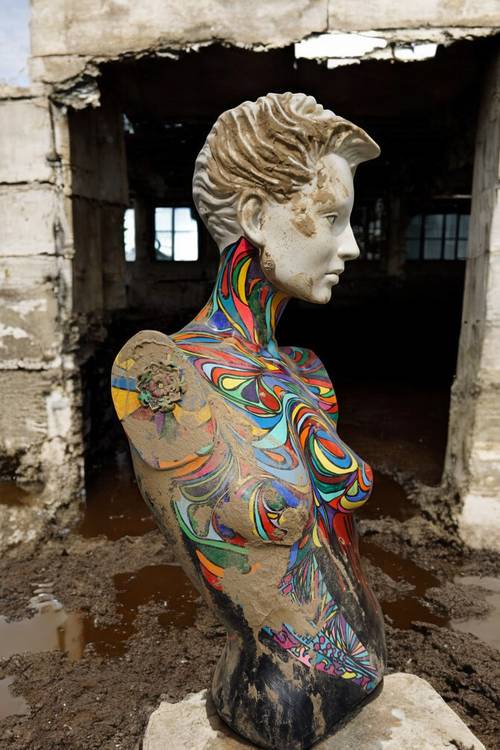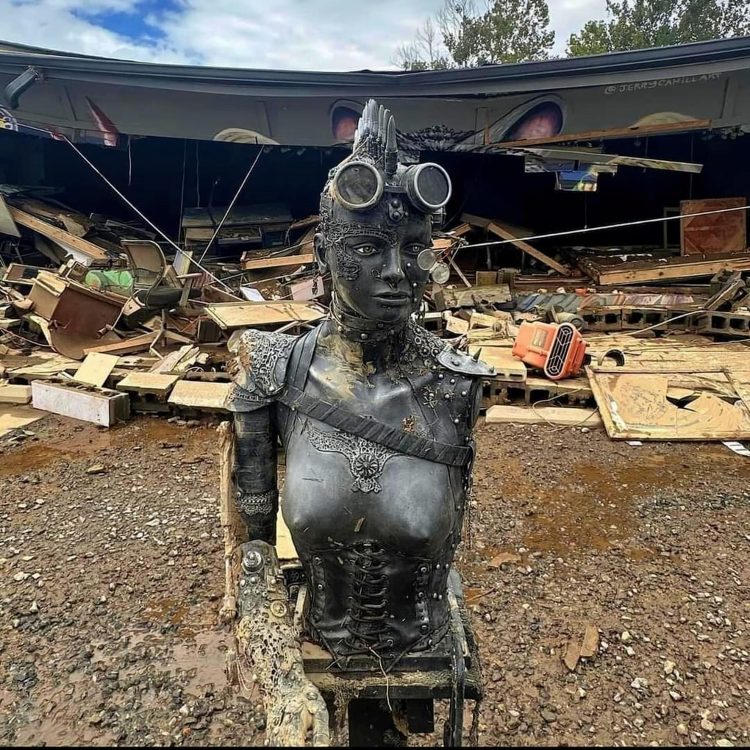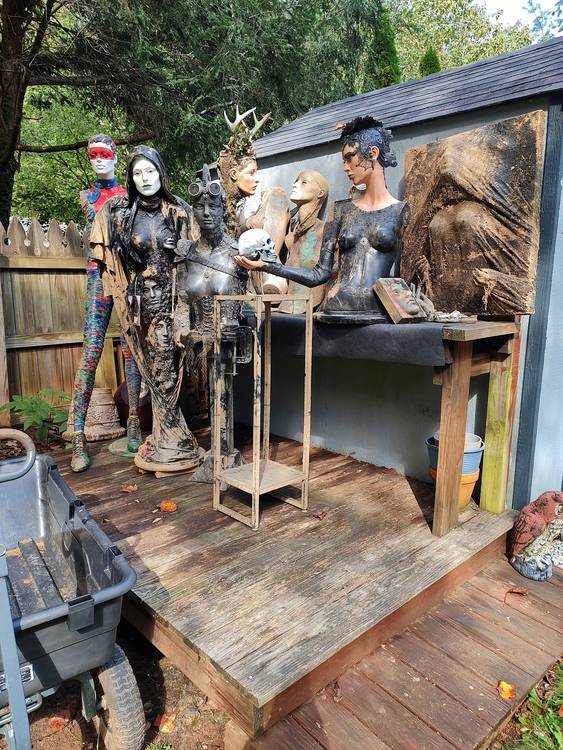Three months after Hurricane Helene devastated Asheville, local artists face significant challenges related to their livelihoods and creative spaces. Limited studio availability, a loss of revenue, and the emotional impact of rebuilding have created unique difficulties for the city’s vibrant art community. One of these artists is Deborah Anderson, who uses assemblage sculptures and digitally manipulated photographs. Anderson’s work often explores themes of identity, transformation, and resilience.

Interview with Deborah Anderson
RRM: Before we discuss Hurricane Helene and its impact, let’s first take a moment to explore your work in greater depth. Your art often delves into profound themes such as identity, womanhood, and mortality, expressed through assemblage sculptures made from old mannequins and the other various mediums you use to create your art. Could you explain how these themes have shaped your creative vision and how you use your chosen mediums to bring these concepts to life? What emotions or insights do you hope viewers take away from your pieces?
Deborah Anderson: My work is deeply rooted in exploring themes of identity, womanhood, and mortality—universal concepts that resonate deeply personally. Using vintage mannequins as my primary medium allows me to examine the human form as a symbol of strength and vulnerability. Once intended to represent societal ideals in our consumer-driven culture, these discarded objects take on new life in my art, embodying stories of resilience and transformation.
Through my assemblage sculptures, I layer elements like patina and fabric and found objects to create pieces that evoke beauty, decay, resilience, and fragility, echoing the complexities of the human experience. I hope viewers feel a sense of connection and introspection, reflecting on the challenges and triumphs of womanhood and the fleeting yet meaningful nature of life. Above all, I want my work to spark conversations that inspire empathy and a deeper understanding of ourselves and each other.
RRM: Your background in nursing, especially in hospice and long-term care, offers a profound lens on life and death. How did those experiences shape your artistic vision? Could you share any specific pieces or collections where this influence is most apparent?
DA: My nursing background, particularly in hospice and long-term care, deeply influence my artistic vision by giving me an intimate understanding of life’s fragility and the strength found in vulnerability. Witnessing moments of profound physical and emotional transition has shaped how I approach themes like mortality and resilience in my work.
One piece where this influence is especially evident is Eternal Contemplation, featuring a vintage mannequin torso holding a skull, a nod to the balance between life and death. The lace embellishments on the torso evoke the delicate beauty of life’s transient nature. These works reflect the beauty and dignity I’ve observed in the human experience, even in its most challenging moments. They invite viewers to confront these shared truths with empathy and introspection.

RRM: Your mannequins are a fascinating medium; you often use them to confront or challenge themes of identity, perhaps those of worth, empowerment, decay, and the beauty of the human form. What drew you to use mannequins, and how do they reflect those societal perceptions?
DA: I was drawn to mannequins because they are inherently symbolic, idealized representations of the female form yet stripped of individuality and identity. By repurposing vintage mannequins, I explore the tension between societal perceptions of worth and empowerment and the fragility of those ideals.
Their weathered surfaces, imperfections, and history allow me to challenge traditional beauty notions and highlight decay and resilience themes. Through my work, I aim to reclaim these forms, transforming them into powerful narratives that question societal expectations and celebrate the complexity of human identity.
RRM: Mixing physical and digital elements lets you create some incredible pieces. Talk about how you made a piece where this mix was essential. What were you hoping to get out of combining these two different styles?
DA: Combining physical and digital elements allows me to expand the narrative potential of my work. For example, I started by photographing one of my vintage mannequin sculptures in “Urban Tag II,” focusing on its intricate textures and worn details. Then, through digital manipulation, I layered graffiti tags, chaotic patterns, and vibrant colors to create a sense of tension and movement around and on the portrait. This mix was essential to conveying themes beyond the tangible—ideas like societal pressures, identity, and emotional fragmentation.
The physical mannequin represents the enduring human form, while the digital layers reflect the chaotic, ever-shifting world we navigate. By blending these two styles, I can create a piece that feels grounded and otherworldly, inviting viewers to explore the interplay between permanence and change.
RRM: Hurricane Helene caused widespread devastation in Asheville. Could you share your personal experience of the flood—what you lost, what you managed to save, and how this event impacted your creative process and your personal life?
DA: Hurricane Helene was an incredibly devastating experience for me and so many others in Asheville. The flood destroyed my inventory at Foundation Studios, wiping out art pieces I had poured my heart into. I managed to save most of my vintage mannequin assemblage sculptures, but they were coated in mud, some filled with water. The loss was overwhelming, and for weeks, I couldn’t bring myself to create. It felt like the flood had washed away not just my work but also my connection to it. Over time, I began to rebuild—not just physically but emotionally—and my creative process shifted. The event deepened my focus on themes of resilience and transformation, and while the sadness still lingers, it has also fueled a renewed sense of purpose in my art.
RRM: The flood upended the lives of many artists, disrupting their access to studios and materials. How did this disruption manifest in your day-to-day creative work, and what strategies did you use to adapt and continue creating amidst the chaos?
DA: The disruption caused by the flood was profound, not just in terms of losing my studio, its artworks, and materials, but in the emotional toll it took. For a while, I couldn’t bring myself to create at all—it felt impossible. I was dealing with the loss of so much work and the uncertainty of what would come next. However, as the dust and mud settled, I found ways to adapt. I started working again in my home studio and rethinking my art approach.
I also began to embrace the chaos and imperfections that came with the situation, letting the damage and the process of rebuilding become part of my work. This shift allowed me to find new inspiration in unexpected places. It was a problematic but transformative experience, and in the end, it pushed me to evolve my creative practice in ways I hadn’t anticipated.
RRM: Your studio at Foundation Studios was destroyed along with the entirety of the building. After the flood, you returned to Trackside Studios, where you had previously shown your work. What was the transition like moving back to Trackside, especially with the challenges of a smaller space (Trackside, too, was flooded but remodeled and reopened on December 8) after the flood? Did this shift influence how you present or create your work?
DA: The transition back to Trackside Studios has been bittersweet. While I was relieved and grateful to have a new space, adjusting to the smaller area was somewhat challenging, especially after losing so much of my previous work.
Trackside had also been affected by the flood, so there was a period of uncertainty. However, the remodeling and reopening in December provided a fresh start and a sense of renewal. It was also great to reconnect with the artists I knew from Trackside and become acquainted with artists I had not met before. Since my space at Trackside is smaller, I have been more intentional with how I use it, which has led me to explore new approaches to creating and presenting my work. The shift also pushed me to experiment with different compositions and scales, making me more conscious of the limitations and opening up new possibilities for creative expression.
Despite the challenges, it has been a rewarding and inspiring process of rediscovery.

RRM: “Where do we go from here?” many River Art District artists are left pondering. How have you and your fellow artists supported one another during this recovery? Have there been any collaborative efforts or shared resources that have stood out to you?
DA: In the aftermath of the flood, the sense of community among River Arts District artists has been incredibly strong. We’ve all leaned on each other for emotional support and practical help. There’s been a collective resilience as we’ve navigated the rebuilding process together.
Many of us have shared resources, from tools and materials to space and advice on dealing with insurance claims or getting back into production. One of the most meaningful collaborative efforts has been how we’ve come together to advocate for each other’s work and visibility. We’ve had group exhibitions to help reintroduce ourselves to the community, and there’s been a constant exchange of ideas and strategies to rebuild our physical spaces and artistic practices. It reminded us that we’re stronger together, even in devastation.
One stand-out collaborative effort has been the Asheville Artists Flood Collection Kickstarter, created by Erica Schaffel and Spencer Beals. The collection consists of a deck of cards and a coffee table book featuring 54 original pieces of art lost or damaged by the flood. I am one of the 54 artists in this collection, which memorializes, honors, and shares these works while putting money directly into the hands of artists who need it.
RRM: Has the experience of Hurricane Helene and its aftermath influenced the themes or messages in your artwork? How do resilience, recovery, and renewal concepts manifest in your current or upcoming projects?
DA: The experience of Hurricane Helene and its aftermath has deeply influenced the themes in my work. The devastation and the process of recovery have shaped my creative direction, with resilience and renewal becoming central to my new pieces.
I find myself focusing on rebuilding, not just physically but emotionally as well. The remnants of what was lost, like the damaged mannequin sculptures I salvaged, now symbolize strength through adversity. In my upcoming projects, I’m exploring how beauty can emerge from destruction and how we, as artists—and people—can find renewal even in the face of loss. It’s been an emotional and transformative process that I’m embracing fully in my work.
RRM: Reflecting on the challenges and growth you’ve experienced, what projects or themes are you most passionate about pursuing in 2025? How do you see your work contributing to the broader narrative of Asheville post-Helene, and what message do you hope to leave with your audience about resilience in the face of adversity?
DA: In 2025, I’m most passionate about continuing to explore themes of resilience, renewal, and the healing power of art. I want my work to reflect personal and collective recovery, mainly as we, as a community, rebuild after the devastation of Hurricane Helene.
One of my main focuses will be on creating pieces that embody the strength to rise from the ashes, drawing inspiration from the scars left behind by the storm. I hope my work contributes to the River Arts District and the Asheville area’s broader narrative by showing how, even in our darkest moments, we can find beauty, strength, and connection through art.
The message I want to leave with my audience is that resilience doesn’t mean returning to how things were; it means evolving, growing, and finding new meaning in the face of adversity.










